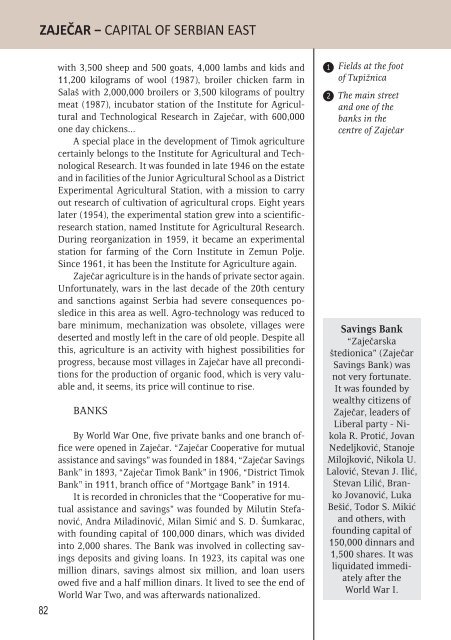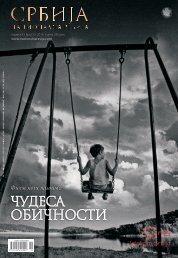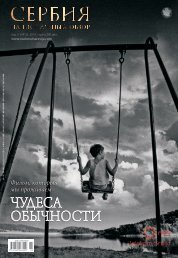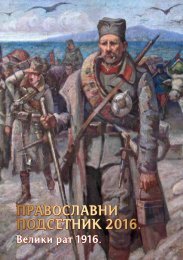Zajecar - engleski - niska rezolucija
Create successful ePaper yourself
Turn your PDF publications into a flip-book with our unique Google optimized e-Paper software.
ZAJEČAR − CAPITAL OF SERBIAN EAST<br />
82<br />
with 3,500 sheep and 500 goats, 4,000 lambs and kids and<br />
11,200 kilograms of wool (1987), broiler chicken farm in<br />
Sa la š with 2,000,000 broilers or 3,500 kilograms of poultry<br />
meat (1987), incubator station of the In sti tu te for Agricultural<br />
and Technological Research in Zaječar, with 600,000<br />
one day chickens...<br />
A special place in the development of Timok agriculture<br />
certainly belongs to the In sti tu te for Agricultural and Technological<br />
Research. It was founded in late 1946 on the estate<br />
and in facilities of the Junior Agricultural School as a District<br />
Experimental Agricultural Station, with a mission to carry<br />
out research of cultivation of agricultural crops. Eight years<br />
later (1954), the experimental station grew into a scientificresearch<br />
station, named In sti tu te for Agricultural Research.<br />
During reorganization in 1959, it became an experimental<br />
station for farming of the Corn In sti tu te in Ze mun Po lje.<br />
Since 1961, it has been the In sti tu te for Agriculture again.<br />
Zaječar agriculture is in the hands of private sector again.<br />
Unfortunately, wars in the last decade of the 20th century<br />
and sanctions against Serbia had severe consequences posle<br />
di ce in this area as well. Agro-technology was reduced to<br />
bare minimum, mechanization was obsolete, villages were<br />
deserted and mostly left in the care of old people. Despite all<br />
this, agriculture is an activity with highest possibilities for<br />
progress, because most villages in Zaječar have all preconditions<br />
for the production of organic food, which is very valuable<br />
and, it seems, its price will continue to rise.<br />
BAN KS<br />
By World War One, five private banks and one branch office<br />
were opened in Zaječar. “Za je čar Cooperative for mutual<br />
assistance and savings” was founded in 1884, “Za je čar Savings<br />
Bank” in 1893, “Za je čar Timok Bank” in 1906, “District Timok<br />
Bank” in 1911, branch office of “Mortgage Bank” in 1914.<br />
It is recorded in chronicles that the “Cooperative for mutual<br />
assistance and savings” was founded by Mi lu tin Ste fano<br />
vić, An dra Mi la di no vić, Mi lan Si mić and S. D. Šum ka rac,<br />
with founding capital of 100,000 di na rs, which was divided<br />
into 2,000 shares. The Bank was involved in collecting savings<br />
deposits and giving loans. In 1923, its capital was one<br />
million dinars, savings almost six million, and loan users<br />
owed five and a half million dinars. It lived to see the end of<br />
World War Two, and was afterwards nationalized.<br />
1<br />
2<br />
Fields at the foot<br />
of Tu pi žni ca<br />
The main street<br />
and one of the<br />
banks in the<br />
centre of Za je ča r<br />
Savings Bank<br />
“Za je čar ska<br />
štedionica” (Za je čar<br />
Savings Bank) was<br />
not very fortunate.<br />
It was founded by<br />
wealthy citizens of<br />
Za je čar , leaders of<br />
Liberal party - Niko<br />
la R. Pro tić, Jo van<br />
Ne delj ko vić, Sta no je<br />
Mi loj ko vić, Ni ko la U.<br />
La lo vić, Ste van J. Ilić,<br />
Ste van Li lić, Branko<br />
Jo va no vić, Lu ka<br />
Be šić, To dor S. Mi kić<br />
and others, with<br />
founding capital of<br />
150,000 dinnars and<br />
1,500 shares. It was<br />
liquidated immediately<br />
after the<br />
World War I.

















